 I have to admit that I was never one to follow the rock press very much. First of all, in America, this usually meant Rolling Stone or Creem Magazine; neither of which ever did anything for me. By the time I would have cared a whit, Rolling Stone was the establishment rock rag of coked up proto-yuppies. It was completely the music publishing arm of The Man®… that is to say if you could deign to find any music coverage in the damned thing! Most of it was specious “lifestyle” editorial/advertising with lots of ads for drug paraphernalia tucked away in the margins. Creem always looked like a heavy metal magazine that was forced to “go punk” by the early 80s. I never bothered.
I have to admit that I was never one to follow the rock press very much. First of all, in America, this usually meant Rolling Stone or Creem Magazine; neither of which ever did anything for me. By the time I would have cared a whit, Rolling Stone was the establishment rock rag of coked up proto-yuppies. It was completely the music publishing arm of The Man®… that is to say if you could deign to find any music coverage in the damned thing! Most of it was specious “lifestyle” editorial/advertising with lots of ads for drug paraphernalia tucked away in the margins. Creem always looked like a heavy metal magazine that was forced to “go punk” by the early 80s. I never bothered.
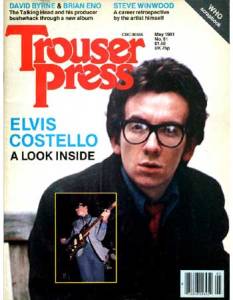 If you had tastes like mine, there wasn’t anything out there with national distribution that came close to serving my interests, until that fateful day in 1981, when a glance at the comic book section of a local Shop + Go revealed the cover at right to my questing eyes. Whaaa…? Elvis Costello and Byrne/Eno on a magazine cover? I had to drop the $1.50 I was probably planning on spending on comic books [you could buy three back then for that price] on this mag instead. It was love at first read. Here was a smart, canny read that covered almost everything I was into musically. Not coincidentally, issue #61 was the first one for the New York magazine to get significant national distribution after seven years of pulling itself up from its fanzine bootstraps into something substantial.
If you had tastes like mine, there wasn’t anything out there with national distribution that came close to serving my interests, until that fateful day in 1981, when a glance at the comic book section of a local Shop + Go revealed the cover at right to my questing eyes. Whaaa…? Elvis Costello and Byrne/Eno on a magazine cover? I had to drop the $1.50 I was probably planning on spending on comic books [you could buy three back then for that price] on this mag instead. It was love at first read. Here was a smart, canny read that covered almost everything I was into musically. Not coincidentally, issue #61 was the first one for the New York magazine to get significant national distribution after seven years of pulling itself up from its fanzine bootstraps into something substantial.
 Editorially, I liked the magazine a lot. I could tell it was written by people who were much more like me than the smug hippies of Rolling Stone! There was some real wit on display, and there was an underlying sense of humor that allowed them to have a few laughs while giving the readers the straight dope. I missed the next issue, but I managed to buy every other subsequent one for the better part of a year. Then something dramatic happened. They started carrying a flexidisc in each issue for subscribers only. Naturally, I had to bite for that one! This made the mag the US equivalent of Flexipop, the scabrous UK music rag with a lock on the whole flexidisc phenomenon…until then! When subscribers got a pair of Orchestral Manoeuvres In The Dark tunes in the year when I could not get enough OMD, it was clearly the impetus that I needed to commit to a monthly subscription.
Editorially, I liked the magazine a lot. I could tell it was written by people who were much more like me than the smug hippies of Rolling Stone! There was some real wit on display, and there was an underlying sense of humor that allowed them to have a few laughs while giving the readers the straight dope. I missed the next issue, but I managed to buy every other subsequent one for the better part of a year. Then something dramatic happened. They started carrying a flexidisc in each issue for subscribers only. Naturally, I had to bite for that one! This made the mag the US equivalent of Flexipop, the scabrous UK music rag with a lock on the whole flexidisc phenomenon…until then! When subscribers got a pair of Orchestral Manoeuvres In The Dark tunes in the year when I could not get enough OMD, it was clearly the impetus that I needed to commit to a monthly subscription.
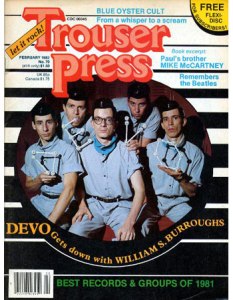 The mag had great features as well. Their autodiscographies were a brilliant conceit: gather up a band and have then discuss each album full of anecdotal detail. They had a page full of reviews of recent singles [heavy on the imports] called Green Circles where Jim Green would weigh in on the caliber of non-LP B-sides for import single cognoscenti like myself. At the very least, you got to know what tracks each single held; invaluable for making a purchasing decision! If the records were 6-8 weeks old by the time they went to press, remember; it was a slower time. It might take that long for anything I wanted to filter down to Central Florida anyway.
The mag had great features as well. Their autodiscographies were a brilliant conceit: gather up a band and have then discuss each album full of anecdotal detail. They had a page full of reviews of recent singles [heavy on the imports] called Green Circles where Jim Green would weigh in on the caliber of non-LP B-sides for import single cognoscenti like myself. At the very least, you got to know what tracks each single held; invaluable for making a purchasing decision! If the records were 6-8 weeks old by the time they went to press, remember; it was a slower time. It might take that long for anything I wanted to filter down to Central Florida anyway.
 The editorial slant of the magazine was such that many acts I was a huge fan of probably got their only national press in their pages. Who else would carry a torch for Ultravox or Lene Lovich? That’s not to say that they spoon-fed me as a reader. If anything, TP [as it was affectionately known], tended to underrate many acts I was pretty big on. Groups like The Psychedelic Furs were a particular sticking point with me, with the band usually summarily dismissed to the pages of “Hit + Run” where also-ran albums deemed unworthy of more than a Tweet-length review of 1-2 sentences were ghettoized. On the other hand, they really did think that Ultravox were the best thing since sliced bread [at least until they turned on them when “Quartet” came out – which was about right].
The editorial slant of the magazine was such that many acts I was a huge fan of probably got their only national press in their pages. Who else would carry a torch for Ultravox or Lene Lovich? That’s not to say that they spoon-fed me as a reader. If anything, TP [as it was affectionately known], tended to underrate many acts I was pretty big on. Groups like The Psychedelic Furs were a particular sticking point with me, with the band usually summarily dismissed to the pages of “Hit + Run” where also-ran albums deemed unworthy of more than a Tweet-length review of 1-2 sentences were ghettoized. On the other hand, they really did think that Ultravox were the best thing since sliced bread [at least until they turned on them when “Quartet” came out – which was about right].
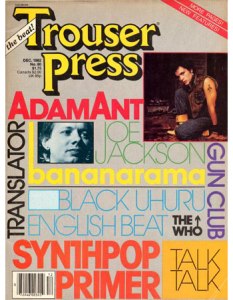 Another huge feature of the magazine was its advertising. I would find out about a lot of interesting records just from their display advertising! I also recall in that innocent, pre-Goldmine era, that there were record dealers who would run ads full of numerous singles listed in detail and using tiny 6 point type that gave me valuable discographical information in that pre-web era! I recall that I saw records that I wanted that never seemed to show up in local record stores, but mail-order purchasing was still a few years out for me. I just didn’t have the money or even a credit card for that sort of thing at the time.
Another huge feature of the magazine was its advertising. I would find out about a lot of interesting records just from their display advertising! I also recall in that innocent, pre-Goldmine era, that there were record dealers who would run ads full of numerous singles listed in detail and using tiny 6 point type that gave me valuable discographical information in that pre-web era! I recall that I saw records that I wanted that never seemed to show up in local record stores, but mail-order purchasing was still a few years out for me. I just didn’t have the money or even a credit card for that sort of thing at the time.
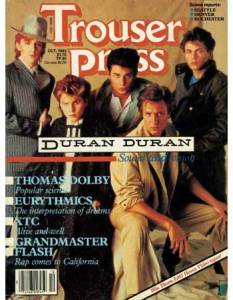 I vividly recall a review of Duran Duran’s “Rio” from publisher Ira Robbins being a full on rave for the magazine full of superlatives and praise. [He did the same for Spandau Ballet’s “True!”] The band had always gotten press in the mag years before it had been determined that putting their mugs on the covers sold a lot of copies to indiscriminate Duranies. When in 1983, the band fell of their perch in a big way, that didn’t stop them from running a now very sellable cover story on the “fab five.” What with MTV igniting the Second British Invasion of 1983, the once demure New Wave mag found itself running cover stories on the likes of Adam Ant, Culture Club, or the now fallen Double Duran as it suffered the cognitive dissonance of selling issues with cover articles about once-obscure groups that they had written short articles on earlier who had since risen to the heights of Top 10 material the world round.
I vividly recall a review of Duran Duran’s “Rio” from publisher Ira Robbins being a full on rave for the magazine full of superlatives and praise. [He did the same for Spandau Ballet’s “True!”] The band had always gotten press in the mag years before it had been determined that putting their mugs on the covers sold a lot of copies to indiscriminate Duranies. When in 1983, the band fell of their perch in a big way, that didn’t stop them from running a now very sellable cover story on the “fab five.” What with MTV igniting the Second British Invasion of 1983, the once demure New Wave mag found itself running cover stories on the likes of Adam Ant, Culture Club, or the now fallen Double Duran as it suffered the cognitive dissonance of selling issues with cover articles about once-obscure groups that they had written short articles on earlier who had since risen to the heights of Top 10 material the world round.
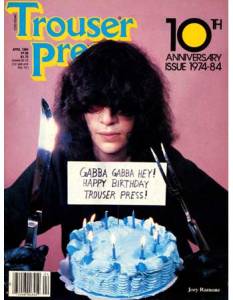 In the end, the decision was made to stop running the magazine, which had been suffering from money problems as well as creeping guilt over its cover artists. The last issue was the tenth anniversary issue from April 1984. The insult to injury? I had just begun a new subscription year and would now receive almost a year’s worth of the worthless magazine The Record. Does anyone remember that rag? By 1984, with music coverage at an all time low in Rolling Stone, the decision was made to launch a separate magazine to just cover music!! I once even bought a back issue of TP at a record show in the 90s [the Gary Numan cover issue this post began with] and if I were to run across any other issues I didn’t have I would probably make the effort to buy them as they would have the allure of retro gold in this fallen era.
In the end, the decision was made to stop running the magazine, which had been suffering from money problems as well as creeping guilt over its cover artists. The last issue was the tenth anniversary issue from April 1984. The insult to injury? I had just begun a new subscription year and would now receive almost a year’s worth of the worthless magazine The Record. Does anyone remember that rag? By 1984, with music coverage at an all time low in Rolling Stone, the decision was made to launch a separate magazine to just cover music!! I once even bought a back issue of TP at a record show in the 90s [the Gary Numan cover issue this post began with] and if I were to run across any other issues I didn’t have I would probably make the effort to buy them as they would have the allure of retro gold in this fallen era.
 The magazine may have died in 1984, but in 1983, the successor made its debut. The Trouser Press Guide To New Wave Records was something of a sourcebook for the genre with hundreds of pages where TP reviews were distilled down to a few sentences and the breadth of the material was amazing for that pre-web era. I never got the first edition, but I have volumes 2-4, which dropped the then badly dated nomenclature “New Wave” from the title. These remain useful years pater, but they are OOP now. There was a Guide to 90s records as well [v. 5] but I had no interest in the music of that decade. Most of the editorial content has been available at trouserpress.com for about a decade now. Head honcho Ira Robbins still keeps the flag flying and I have to admit, I take part in the discussion on the active forum there as well. It’s fun, but nothing will ever take the place of the original magazine that managed to feed my mania for the nominal price of $1.50-2.00 an issue back in those days. For me, buying music instead of rock press was the thing. Expensive $3.00 import copies of the NME or Melody Maker represented money better spent on actual music. TP filled an important void at an attractive price for me.
The magazine may have died in 1984, but in 1983, the successor made its debut. The Trouser Press Guide To New Wave Records was something of a sourcebook for the genre with hundreds of pages where TP reviews were distilled down to a few sentences and the breadth of the material was amazing for that pre-web era. I never got the first edition, but I have volumes 2-4, which dropped the then badly dated nomenclature “New Wave” from the title. These remain useful years pater, but they are OOP now. There was a Guide to 90s records as well [v. 5] but I had no interest in the music of that decade. Most of the editorial content has been available at trouserpress.com for about a decade now. Head honcho Ira Robbins still keeps the flag flying and I have to admit, I take part in the discussion on the active forum there as well. It’s fun, but nothing will ever take the place of the original magazine that managed to feed my mania for the nominal price of $1.50-2.00 an issue back in those days. For me, buying music instead of rock press was the thing. Expensive $3.00 import copies of the NME or Melody Maker represented money better spent on actual music. TP filled an important void at an attractive price for me.
– 30 –

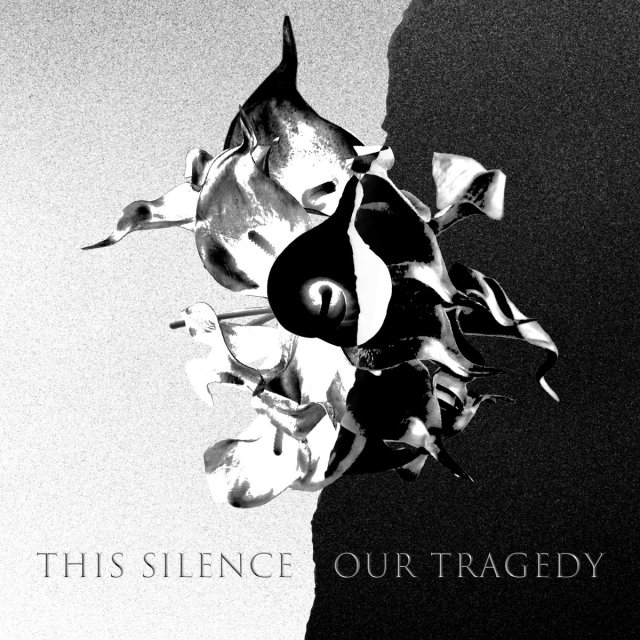


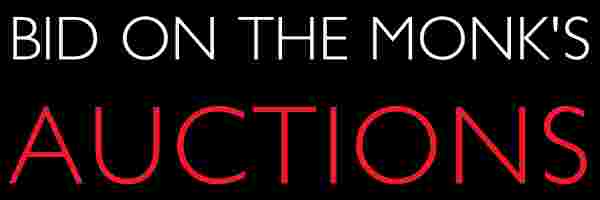


![Chris Cross: 1952-2024 [part 2]](https://i0.wp.com/postpunkmonk.com/wp-content/uploads/2024/04/ultravox-cross.jpg?resize=200%2C200&ssl=1)



I bought my first Rolling Stone in 1977 or so, but when i discovered Trouser Press (it was an issue with Ric Ocasek on the cover, google tells me it was August 1979) that immediately became my new music bible. I gobbled every issue, ads included, and used it as a guideline of what exciting stuff to buy that i knew I’d never hear on the radio surrounding me in upstate New York. They regularly featured my idols (Blondie, Ramones, Clash) on their cover, and in one particularly memorable outing they mocked up an National Enquirer type tabloid with salacious Pete Shelley headline. How I loved this publication. Not an exaggeration to say that I was in near tears when they folded.
Love the books too. Utterly genius writing…I laugh hysterically just thinking about how a reviewer once compared Gene Loves Jezebel to a U2/billy goat hybrid. I like GLJ, but I like witty, insightful reviews even more.
LikeLike
Taffy – Yep, there was nothing else to compare to the kicks waiting between the covers for New Wave Hipsters back in the day. Orlando had a local New Wave newspaper [“Dogfood”] back in the day but this was a whole ‘nother ball game.
LikeLike
Sadly TP went away just as I was getting into that sort of music, so I had to make do with whatever magazines I could find. The guide books were a godsend, though–I didn’t need the reviews, just the information so I knew what to look for in the few college area indie stores I knew of! :)
LikeLike
Jon Chaisson – Well you’re in luck. Publisher Robbins has been scanning and posting entire issues to the TP Facebook page, if you want to view them anew. He’s about done with the first 16 or so issues, if memory serves. Of course, back in the early 70s, TP was a more mainstream rock mag with a line in straight Anglophilia from ’73-’78 or so, but by that time the tide had turned in its coverage to the new breed. So long interviews with Roy Harper were out.
LikeLike
Sweet! I can consider it reference for all the empty spots in my collection for that era. :)
LikeLike
I was a big fan of Q and Uncut out of the UK until the quality went out of Q (and it became a Details-wannabe) and Uncut became this hipster thing….we liked this band when no one knew who they were and now they have a record and they’re already sold out, too bad you didn’t see that one pub date they did……
Especially Uncut circa the late 90’s was a solid magazine with some real content, especially for Yanks who don’t receive the press that UK bands receive in the UK. I have some old issues with really comprehensive bios of acts like New Order and Electronic and their cover mounted cd of the best new music, damn there are a lot of bands that owe them a thank you for the inclusion of a track on one of those that led me to buy one, two, three, four or more albums. Just superb comps that stood up to repeated listens all on their own.
Honorable Mention to NME spinoff Select, the written content wasn’t that great but in the early 90’s it was a great venue to just see stuff. Great photo layouts and the occasional good interview.
LikeLike
Tim – I bought Q from issue 18 or so up to issue 60-omething. Once the US cover price leapfrogged the mystical $4.95 it was no longer viable. How I wish I’d saved those rags for ebay instead of throwing them out! But ebay didn’t exist for another six years.
LikeLike
Heavy Metal isn’t something that one associates with music reviews…my father-in-law has a pretty much complete run of the first few years and their music and movie reviews are dead on. Whoever was writing for them had a clear eye for cutting through marketing & hype.
LikeLike
Tim – Funny you should mention Heavy Metal’s music criticism. I never had time for the mag as a youth. It seemed like proto-porn for horny teenaged sci-fi nerds who couldn’t pass muster trying to buy the latest Playboy. A phenomenon to be avoided. At one point in the early mid-80s, I was at a comic book store with my friend Tom and we came across a run of HM from maybe ’80-’81 in a cheapie bin and he waxed eloquent about a story called “Changes” by Matt Howarth that had been serialized in it and he made me buy them for the 50¢ the store was asking. The story was fantastic, but the rest of the mag was missable. With the exception of the amazingly great music criticism by one Lou Stathis. You are 100% correct in stating that it was spot on. I can’t recall ever reading any music writing that managed to hit marks that really meant so much to me with laser-like accuracy. Crimson. Nelson. Ultravox. If it was astounding, he was all over it.
LikeLike
TP was a bible for me. I came to know it in late ’78 and for the most part it reinforced my views of music. One of TP’s greatest assets was that it never really lost its fanzine roots. Ira Robbins was a fan, first and foremost. Yes he was a critic, yes he was a editor/publisher who had to adapt to grow, but TP survived a very long time being itself.
Now I can certainly agree that there was a period around ’81 when a lot of the bands I was really focusing on were getting sort shrift in TP – The Furs is a great example. But I never really needed a magazine, a writer or an editorial department to influence my musical direction. It certainly was great when that Magazine, a writer or Ed. Dept. did agree with my opinions.
The closest any UK mags got to TP were the aforementioned Flexipop and Zigzag in the late 70s and early 80s.
LikeLike
Echorich – I hear you there on influencing musical direction, but I wasn’t getting at that angle. I was more disappointed that when the Furs put out a new album for the first four platters, I felt it was worthy of more in-depth discussion and would have liked to have read it in the mag instead of two glib sentences in “Hit + Run.” For everyone I knew, The Furs were major players, at least until they dropped the ball on “Midnight To Midnight.”
LikeLike
I agree. One thing that always made TP Ira Robbins’ magazine was that his personal editorial bent did influence quite a lot of what was focused on – especially in the early days. I’ve always been a fan of reading “critics” reviews, whether in TP, The Village Voice, Rolling Stone, NME, just to see if I understood their perspective or cold spot those that you knew REALLY didn’t listen to the album they were reviewing. Some critics were obviously failed fiction writers who to advantage of page space to “create” rather than critique. Those reviews could be a lot of fun or cause you to throw a magazine across the room. These days those writers seem to be clogging up the internet in places like All Music. I’ll never forget a review of Comsat Angel’s fourth album, Land, that was in NME. It read more like a short story about late nights and walking in the shadows and finally spent the last paragraph or so discussing the band’s change of sound to incorporate more synths and pop and leave behind their Post Punk roots on the studio cutting room floor. It was a rubbish review of a (what I consider) misunderstood album.
LikeLike
Totally agree re Land, unfairly maligned. Lots of excellent and sometimes beautiful songs.
LikeLike
I had a mess of TP, but I got rid of almost all of them during a move many years ago. I couldn’t bring myself to part with all of the ones with Costello on the cover, however. So, I still have that one you’re showing above and a few others. Going to pull those out tonight. Thanks for the stroll down memory lane. Most enjoyable.
LikeLike
Didn’t encounter TP here in the UK, just knew the name. It does again reinforce how important mags like this were as sources of info in those pre internet days.
I do remember standing in a book shop just off Oxford Street in maybe ’86 reading what I’m pretty sure was the International Discography of the New Wave and being amazed to find my then favourite band the Sound were previously a punk band called the Outsiders….these days that info would be a click away.
LikeLike
I remember this – great magazine – I had the one with Elvis Costello on the cover and a few other issues – thanks for posting – also RIP Charlie Watts
LikeLike
blackwings666 – Welcome to the comments! Trouser Press was my musical bedrock for three short years. I wish I had discovered them earlier but the distribution just wasn’t there. At least we can now catch up digitally from the website.
LikeLiked by 1 person